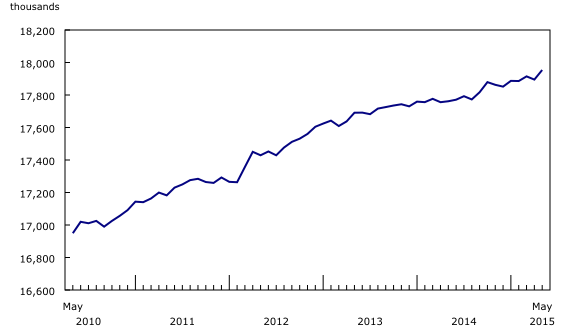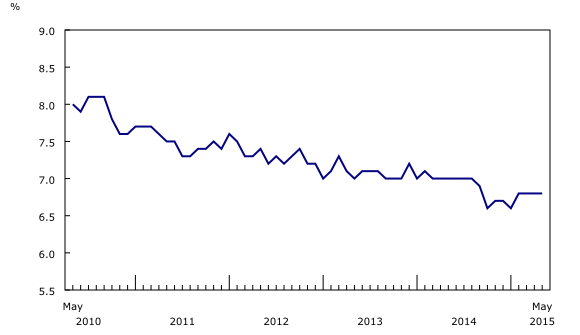Labour Force Survey, May 2015
Archived Content
Information identified as archived is provided for reference, research or recordkeeping purposes. It is not subject to the Government of Canada Web Standards and has not been altered or updated since it was archived. Please "contact us" to request a format other than those available.
Released: 2015-06-05
Employment increased by 59,000 in May, driven by gains in the number of private sector employees. The number of people participating in the labour market also rose in May, leaving the unemployment rate unchanged at 6.8% for the fourth consecutive month.
Since the beginning of 2015, employment gains have averaged 20,500 per month.
In the 12 months to May, employment increased by 192,000 (+1.1%), the result of more full-time work. Over the same period, the total number of hours worked grew by 1.2%.
Employment gains in May were highest among men aged 25 to 54, followed by men aged 55 and older. However, there was little change among the other demographic groups.
Provincially, employment increased in Ontario, British Columbia and Nova Scotia, while it declined in Newfoundland and Labrador, Manitoba and New Brunswick.
In May, there were more people working in manufacturing as well as in health care and social assistance. Additionally, employment rose in retail and wholesale trade; business, building and other support services; as well as in finance, insurance, real estate and leasing. In contrast, there were fewer workers in public administration and agriculture.
The number of private sector employees increased in May, while there was little change in self-employment. At the same time, public sector employment edged down.
Employment up for men aged 25 and older
For men aged 25 to 54, employment increased by 20,000 and their unemployment rate was unchanged at 6.0%, as their participation in the labour market also increased. In the 12 months to May, employment rose by 48,000 (+0.8%) for this group.
In comparison, employment in May was little changed for women aged 25 to 54 and the unemployment rate held steady at 5.2%. On a year-over-year basis, employment gains for this group totalled 46,000 (+0.8%).
For men aged 55 and older, employment rose by 14,000. However, their unemployment rate increased 0.5 percentage points to 6.4% as more of them searched for work. Compared with 12 months earlier, employment for this group increased by 68,000 (+3.6%), mostly a result of population aging.
For women aged 55 and older, employment was little changed in May and compared with 12 months earlier. However, their unemployment rate fell 0.6 percentage points to 4.9% in May, as fewer women aged 55 and older searched for work.
Employment among youths aged 15 to 24 was also little changed both in May and on a year-over-year basis. Their unemployment rate was 13.2% in May.
Employment gains in Ontario and British Columbia
In Ontario, employment rose by 44,000 in May, pushing the unemployment rate down 0.3 percentage points to 6.5%. This employment increase accounted for most of the 53,000 (+0.8%) year-over-year gains for the province.
In May, employment increased by 31,000 in British Columbia, mostly in part-time work. This follows a similar-sized decrease in April, which was mainly in full-time employment. The unemployment rate was virtually unchanged at 6.1% in May, as more people participated in the labour market. In the 12 months to May, employment in the province was little changed.
In Nova Scotia, employment rose by 3,700 in May and the unemployment rate was 8.8%. Prior to this increase, employment in the province had been trending downward since January.
Employment in Newfoundland and Labrador fell by 4,300 in May, and the unemployment rate increased 1.2 percentage points to 13.8%. Employment in the province has been on a downward trend since November.
In Manitoba, 3,200 fewer people worked in May and the unemployment rate was 5.7%. Despite this employment decline, Manitoba had the highest rate of growth among all provinces in the 12 months to May, up 2.3% or 14,000.
There were 2,800 fewer people employed in New Brunswick in May and the unemployment rate was 9.6%. On a year-over-year basis, employment in the province was unchanged.
In May, employment was little changed in Alberta. The unemployment rate increased 0.3 percentage points to 5.8%, the highest rate since January 2011. On a year-over-year basis, employment gains totalled 38,000 (+1.7%). However, there has been little employment growth in the province since the start of 2015.
Employment in Quebec was virtually unchanged in May and the unemployment rate was 7.6%. However, compared with May 2014, employment in the province increased by 70,000 (+1.7%), with most of the growth in the first four months of 2015.
Industry perspective
Manufacturing employment increased for a second consecutive month, up 22,000 in May. These recent increases brought employment in the industry to a level similar to that of May 2014.
The number of workers in health care and social assistance rose by 21,000 in May. Compared with 12 months earlier, employment in the industry increased by 75,000 (+3.4%), one of the strongest growth rates among all industries.
There were 17,000 more people employed in retail and wholesale trade in May. On a year-over-year basis, however, employment in the industry was little changed as gains in wholesale trade were offset by declines in retail.
In business, building and other support services, employment rose for the second consecutive month, up 13,000 in May. These recent increases contributed to the year-over-year gain of 29,000 (+3.9%).
Employment in finance, insurance, real estate and leasing increased by 13,000 in May, bringing employment up 34,000 (+3.2%) over the past 12 months.
In public administration, employment declined by 12,000 in May, continuing the downward trend that began last fall. Compared with May 2014, employment in this industry was down 25,000 (-2.7%).
Employment also decreased in agriculture (-6,600), contributing to the year-over-year decline of 19,000 (-6.1%).
The number of private sector employees increased by 57,000 in May, while there was little change in self-employment. At the same time, public sector employment edged down.
In the 12 months to May, the number of private sector employees rose by 118,000 (+1.0%) and public sector employment increased by 42,000 (+1.2%). Over the same period, self-employment was little changed.
Summer employment for students
From May to August, the Labour Force Survey collects labour market data about youths aged 15 to 24 who were attending school full time in March and who intend to return to school full time in the fall. The May survey results provide the first indicators of the summer job market, especially for students aged 20 to 24, as many students aged 15 to 19 are still in school. The data for June, July and August will provide further insight into the summer job market. The published data are not seasonally adjusted and, therefore, comparisons can only be made from one year to another.
The employment rate among returning students aged 20 to 24, that is, the number of employed as a percentage of their population, was 59.0% in May, little changed from a year earlier. The unemployment rate for this group of students was 15.1% in May, up 1.5 percentage points from May 2014.
Note to readers
The Labour Force Survey (LFS) estimates for May are for the week of May 10 to 16.
The LFS estimates are based on a sample and are therefore subject to sampling variability. As a result, monthly estimates will show more variability than trends observed over longer time periods. For more information, see "Interpreting Monthly Changes in Employment from the Labour Force Survey." Estimates for smaller geographic areas or industries also have more variability. For an explanation of sampling variability of estimates and how to use standard errors to assess this variability, consult the "Data quality" section of the publication Labour Force Information (Catalogue number71-001-X).
This analysis focuses on differences between estimates that are statistically significant at the 68% confidence level.
The employment rate is the number of employed persons as a percentage of the population 15 years of age and over. The rate for a particular group (for example, youths aged 15 to 24) is the number employed in that group as a percentage of the population for that group.
The unemployment rate is the number unemployed as a percentage of the labour force (employed and unemployed).
The participation rate is the number of employed and unemployed as a percentage of the population. For more detailed information, see the Guide to the Labour Force Survey (Catalogue number71-543-G).
Seasonal adjustment
Unless otherwise stated, this release presents seasonally adjusted estimates, which facilitates comparisons by removing the effects of seasonal variations. For more information on seasonal adjustment, see Seasonally adjusted data – Frequently asked questions.
Sample redesign
Every 10 years, the LFS undergoes a sample redesign to reflect changes in population and labour market characteristics, as well as new definitions of geographical boundaries. The redesigned sample was introduced starting in January 2015 and will be fully implemented by June 2015.
A more detailed summary, Labour Force Information (Catalogue number71-001-X), is now available for the week ending May 16. From the Browse by key resource module of our website under Publications, choose All subjects then Labour.
Summary tables are now available online. From the Browse by subject module of our website, choose Labour.
The next release of the Labour Force Survey will be on July 10.
An updated issue of the Guide to the Labour Force Survey (Catalogue number71-543-G) is now available from the Browse by key resource module of our website under Publications.
Contact information
For more information, contact us (toll-free 1-800-263-1136; 514-283-8300; infostats@statcan.gc.ca).
To enquire about the concepts, methods or data quality of this release, contact Vincent Ferrao (613-951-4750; vincent.ferrao@statcan.gc.ca) or Lahouaria Yssaad (613-951-0627; lahouaria.yssaad@statcan.gc.ca), Labour Statistics Division.
- Date modified:



